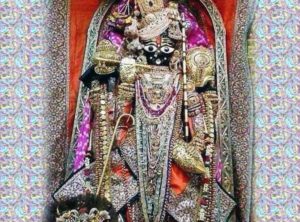Above the entrances and elsewhere around the temple are closed-circuit TVs showing the Deity, but the pilgrims are not much interested in them. They want to get in and see the Deity as He is. Streams of people pour into the main gates, as others pour out the side gate. The front gates are barricaded to allow people to enter in shifts. The women use a separate entrance, and once inside they stand in front of the men, separated by a barrier. All the pilgrims see the Deity and then go outside and circumbulate the temple.
in them. They want to get in and see the Deity as He is. Streams of people pour into the main gates, as others pour out the side gate. The front gates are barricaded to allow people to enter in shifts. The women use a separate entrance, and once inside they stand in front of the men, separated by a barrier. All the pilgrims see the Deity and then go outside and circumbulate the temple.
To have darsana of the Lord during arati is auspicious, but the aratis last only a few minutes, so there’s a tremendous rush. Inside the temple,the security forces blow whistles to control the crowd but they have very little effect as thousands of people push and shove their way around one another. No one seems to mind them. The Lord’s big eyes look kindly upon His devotees. Everyone is happy chanting the Lord’s names and having His darsana.
 People bring boxes of sweets, open them, hold them above their heads, and offer the sweets by waving their hands toward the Lord over the boxes. They will take the sweets home and give them to people in their villages. In front of the temple a shop sells tulasi leaves to place on sweets bought to be offered to Ranchor Raya.
People bring boxes of sweets, open them, hold them above their heads, and offer the sweets by waving their hands toward the Lord over the boxes. They will take the sweets home and give them to people in their villages. In front of the temple a shop sells tulasi leaves to place on sweets bought to be offered to Ranchor Raya.
Apart from Ranchor Raya, Dakor is also famous for gota, lota, and phota. Gota means a local variant of pakora (batter-dipped, deep-fried vegetable) made with coarse chickpea flour and fenugreek leaves and served with yogurt. Lota means a drinking cup; many copper, steel, and aluminium lotas are available in Dakor. Phota means a photo of the deity. These are the things people like to buy.
#Dakor #holyland #india #spirituality #devotional
Source: Gauranga Das Facebook